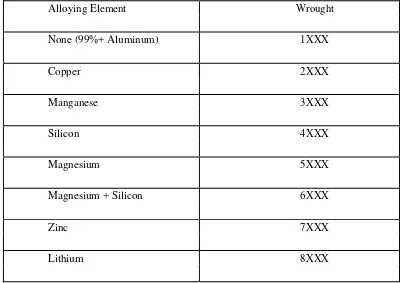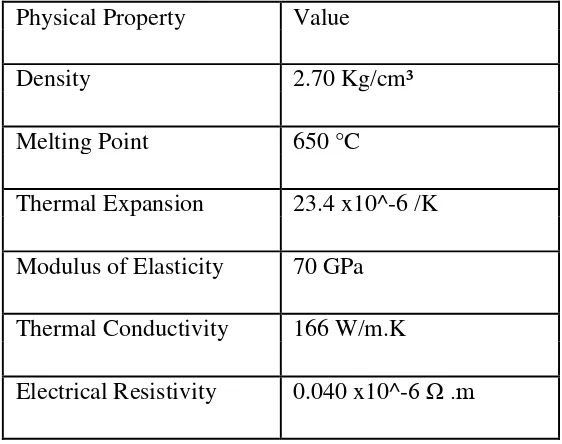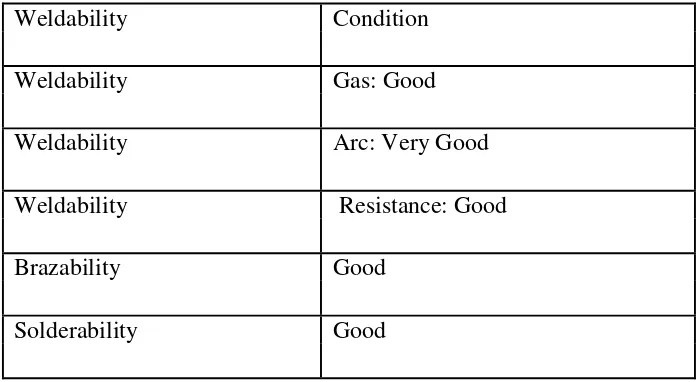MODELING AND OPTIMIZATION THE EFFECT OF PROCESS VARIABLES ON MECHANICAL PROPERTIES
OF AL- 6061 T6 ROBOTIC CO2 WELDMENTS
SEAN JOHN MATHEW
SUPERVISORS DECLARATION
“I hereby declare that I have read this thesis and in my opinion this report is sufficient in terms of scope and quality for the award of the degree of
Bachelor of Mechanical Engineering (Design and Innovation)”
Signature :
Supervisor : Dr. S. Thiru Chitrambalam
ii
MODELING AND OPTIMIZATION THE EFFECT OF RESPONSE
VARIABLES ON MECHANICAL PROPERTIES OF AL- 6061 T6
ROBOTIC GMAW WELDMENTS
SEAN JOHN MATHEW
This thesis is submitted to Faculty of Mechanical Engineering,
in partial fulfillment for the award of Bachelor's Degree in
Mechanical Engineering (Design and Innovation)
Faculty of Mechanical Engineering
Universiti Teknikal Malaysia Melaka
iii
DECLARATION
“I hereby declare that the work in this report is my own except for summaries and quotations which have been duly acknowledged.”
Signature : ………..……….
Author : ………...
iv
But seek ye first the kingdom of God, and his righteousness; and all these things shall be added unto you
v
ACNOWLEDGEMENT
I would sincerely thank my parents for all the support and care throughout
my studies as well as giving me the support that I needed to complete my degree.
I also would like to give a special thanks to my supervisor and my mentor,
Dr. S. Thiru Chitrambalam for all the support and guidance in completing this
project as well as the invaluable knowledge that he shared with me, his teaching
vi
ABSTRAK
Kimpalan struktur Aluminium yang menggunakan T6-6061 adalah satu proses yang
kompleks dan mencabar kerana kesukaran dalam mencari kimpalan parameter
kawalan proses optimum untuk mencapai sifat-sifat mekanik yang baik seperti
kekerasan dan kekuatan hasil kimpal itu. Pemilihan parameter optimum yang secara
umumnya adalah berdasarkan kepada kemahiran dan pengetahuan tentang
juruteknik yang terlibat dan masa dan bilangan memakan kos percubaan dan
kesilapan berjalan. Satu percubaan telah dibuat itu untuk menyiasat secara
sistematik pengaruh parameter kawalan proses kekerasan manik Aluminium
6061-T6 dengan menggunakan Response Surface Method (RSM) dengan lima tahap reka
bentuk komposit empat faktor utama untuk mewakili hubungan antara kimpal
faktor proses dan tindak balas mereka. Model matematik telah dibangunkan untuk
menunjukkan hubungan antara pembolehubah proses dan jawapan mereka yang
akan membantu para jurutera kilang untuk memilih dan mengawal pembolehubah
proses berkesan, untuk mencapai keputusan yang dikehendaki. Ia telah mendapati
vii
ABSTRACT
Welding of Aluminium structures that uses T6-6061 is a complex and
challenging process due to the difficulties in finding the optimum weld process
control parameters for achieving the desirable mechanical properties such as
hardness and strength of the weldment. The optimum parameters selection which
generally is based on the skill and knowledge of the technicians involved and the
time and cost consuming number of trial and error runs. An attempt was hence
made to systematically investigate the influence of process control parameters on
the hardness of the bead of Aluminum 6061-T6 by applying Response Surface
Methodology (RSM) technique with five level four-factor central composite design
to represent the correlation between the weld process factors and their response.
Mathematical models were developed to show the relationship between process
variables and their responses that will help the plant engineers to select and control
process variables effectively, to achieve the desired results. It has been found that
viii
TABLE OF CONTENT
CHAPTER CONTENTS PAGE
DECLARATION II
DEDICATION III
ACKNOWLEDGEMENT IV
ABSTRAK V
ABSTRACT VI
LIST OF TABLES IX
LIST OF FIGURES X
CHAPTER 1 INTRODUCTION 1
1.0 Introduction 1
1.1 Background 1
1.2 Problem Statement 2
1.3 Objective 3
1.4 Scope 3
ix
CHAPTER II LITERATURE REVIEW 4
2.1 Aluminium 4
2.2 Introduction To Gas Metal Arc Welding 8
2.3 Welding Parameters 8
2.4 Weld Bead Geometry 16
2.4.1. Weld Bead Shape 16
2.4.2 Weld bead width 17
2.4.3 Penetration 17
2.4.4 Reinforcement 18
2.4.5 Respond Surface Methodology 18
CHAPTER III METHODOLOGY 20
3.1 Introduction 20
3.2 Flow Chart 20
3.3 Developing The Design Matrix 22
3.4 Experimental Procedure 24
CHAPTER IV RESULTS 31
4.0 Results 31
4.1 Developing models and calculating the coefficient of model
33
x
4.3 Testing the Coefficient for significant 35
4.4 Development of Final Model 37
CHAPTER IV RESULTS 31
4.0 Results 31
4.1 Developing models and calculating the
coefficient of model
33
4.2 Checking the adequacy of the model 34
4.3 Testing the Coefficient for significant 35
4.4 Development of Final Model 37
CHAPTER V DISCUSSION 41
5.1 Introduction 41
5.2 Significant Process Parameter 42
5.2.1 welding voltage and welding current on Hardness
42
5.2.2Welding voltage and welding current on hardness
42
CHAPTER VI CONCLUSIONS 44
6.1 Conclusions 44
6.2 Recommendations 45
REFERENCES 46
xi
LIST OF TABLES
NO TITLE PAGE
2.1 Alloying Elements Of Aluminum 5
2.2 Physical Properties Of AL 6061-T6 6
2.3 Weldability Of Aluminum 6061-T6 7
3.1 Process Parameters 22
3.2 Design Matrix 23
3.3 Chemical Composition Of Base Plate And Electrode Wire 24
3.4 Hardness Value on the bead 30
4.1 Design matrix and observed values of hardness 32
4.2 Regression Coefficient 33
4.3
Calculation of variance for testing the adequacy of the
models 34
xii
LIST OF FIGURES
NO . TITLE PAGE
2.1 GMAW process 8
2.2 GMAW Robotic at FKP LAB 8
2.3 Effect of Arc Voltage on bead shape 11
2.4 Welding speed on cracking 12
2.5 Effect of electrode angle on fillet welds 14
2.6 Effect of electrode angle on butt welds 14
2.7 Bead Geometry 16
3.1 Flow Chart 22
3.2 Specimen Sampling plan 25
3.3 Grinding Process using different sand paper 26
3.4 After Etching with Keller’s Reagent 26
3.5 Measuring of the bead using Dyno-lite 27
3.6 Cross section of an ideal weld bead 28
3.7 Specimen undergoing hardness test as ASTM E18 29
4.0 Predicted value versus actual value 37
4.1 Effect of welding current on Hardness 38
xiii
4.3 Surface plot for Interaction effect of Welding voltage and Welding Current on Hardness
39
4.4 Surface plot for Interaction effect of Welding current and Welding speed on Hardness
40
4.5 Contour plot for interaction effect voltage and welding current on hardness
41
4.6 Contour plot for interaction effect welding speed and welding current on hardness
41
4.7 Contour plot for interaction effect welding speed and voltage on hardness
1
CHAPTER I
INTRODUCTION
This chapter describes the background of Gas metal arc welding (GMAW)
as well as Aluminum Alloy 6061T6. Subsequent is followed by the problem
statement of the thesis project. Next, the objective of project will be explained and
the scope of the project being covered. This chapter will end with the outline of the
Thesis.
1.1 BACKGROUND
Gas metal arc welding (GMAW) process is largely common among
researchers as well as in the industries and is commonly preferred for welding
mainly in automobile and marine industry due to its exceptional mechanical
properties (Baghel, 2012). The significance of a good weld joint is influence by the
2
AL 6061-T6 also known as strengthened metal matrix composites (MMCs)
due to its chemical composition where it has at minimum two parts of essential
part, one presence of a metal. Reinforced metal matrix compounds are finding its
way into engineering practices. In applications where good ability to endure high
relative temperature as well the necessities of high specific strength and stiffness
are the distinctive features of composite materials, AL 6061 T6 have its advantage.
Al 6061-T6 alloys are extensively used for viable uses in the engineering
industries. One of the many advantages of Al 6061-T6 is that it has exceptional
mechanical properties which allow it to be machined swiftly and sparingly.
1.2 PROBLEM STATEMENT
There are problems is faced by manufacture everywhere to control the
process factor parameters to have a good weld with that have a minimal residual
stresses. It is significant to decide the weld input with every new product within
the specifications thus making it more troublesome. A pain staking test and error
process with weld key in parameters heavily relying on the skills of the technician,
Next welds are separately examine to decide whether it satisfy the requirement by
conducting several test. Finally if all is well, the weld parameters are chosen
together with the technician can proceed with the welding process. Therefore to
overcome this problem, several optimization methods that can be developed to
develop a mathematical model equation to specify the relationship between
3
1.3 OBJECTIVES
1. To investigate a study and record the relationship between process
variables and mechanical properties during the robotic welding of AL 6061 T6
alloys
2. To develop mathematical models. In addition, to predict, compare the
developed model for optimization of responses
1.4 SCOPE
The scope of this research will cover the literature reviews that are related to
this project. Besides that, the scope is to study, understand the theory and
correlation between the weld control factors and the response variables during
robotic GMAW process. In addition, it will also apply design of experiment
methodologies to develop mathematical models for prediction of responses and
optimization
1.5 THESIS OUTLINE
Chapter One describes the main objective of this project and its scope of
study. In Chapter Two, there is a complete literature study of the effects of
response variable on mechanical properties and which related to this project.
Chapter Three explains more in details about the method used to achieve the
project objective. Chapter Four explains about the preparation for the experiment
and Chapter Five explains about the testing and results analyzing from the
experiment. Chapter Six explains the discussion made based on the overall results
obtained. Conclusion and recommendation are explained in the final chapter of this
4
CHAPTER II
LITERATURE REVIEW
2.1 ALUMINIUM
Aluminium Alloys can be defined as a substance consists of metallic
properties that have two or more element of which aluminum is the main part
comprising 90-96% which other elements are added to provide a specific
properties and characteristic
Aluminium has a very interesting characteristic that industries are
favorable for usage The low density and high strength to weight ratio are one of
the reasons why aluminum and its alloys are used widely in aerospace and
automotive businesses. Aluminium comes in different size and type of application
usage. Generally, Aluminium series are determined by the type of alloying element
present which will influence that typical application and the characteristic of the
5
Table 2.1 : Alloying Element of Aluminum (Kaufman, 2000)
Alloying Element Wrought
None (99%+ Aluminum) 1XXX
Copper 2XXX
Manganese 3XXX
Silicon 4XXX
Magnesium 5XXX
Magnesium + Silicon 6XXX
Zinc 7XXX
Lithium 8XXX
Based on Table 2.1, For an example, for the 3XXX series the minor
alloying element is manganese. 3XXX series alloys are non-heat treatable that can
be strengthen using cold work. As for 6XXX series, it contains both magnesium
and silicon that will have a different characteristic than other series. 6XXX series
are heat treatable and that have high corrosive, resistive, excellent extrudability
6
Table 2.2: Physical Properties of AL 6061-T6 (Kaufman, 2000)
Physical Property Value
Density 2.70 Kg/cm³
Melting Point 650 °C
Thermal Expansion 23.4 x10^-6 /K
Modulus of Elasticity 70 GPa
Thermal Conductivity 166 W/m.K
Electrical Resistivity 0.040 x10^-6 Ω .m
Table 2.2, consist of the physical properties of Aluminum 6061-T6 which
have a modulus of elasticity of 70Gpa which makes it a primary usage in
architectural and structural members besides that, the special properties of this
[image:20.612.166.447.126.348.2]7
Table 2.3:Weldability of Aluminum 6061-T6 (Kaufman, 2000)
Weldability Condition
Weldability Gas: Good
Weldability Arc: Very Good
Weldability Resistance: Good
Brazability Good
Solderability Good
Based on Table 2.3, Aluminum 6061-T6 has a good working condition
on several Weldability. Brazing and Soldering have a good working condition
9
2.3 WELDING PARAMETERS
The selection of the precise welding circumstances for the plate width and
joint planning to be welded is very vital if acceptable joints free from flaws such
as cracking, porosity and undercut are to be acquired. The process factors, which
have to be considered, are:
a. Electrode polarity.
b. Welding current.
c. Electrode diameter.
d. Arc voltage.
e. Welding speed.
f. Electrode extension.
g. Electrode angle.
h. Flux depth.
These are the factors that govern bead size, bead shape, and depth of infiltration
and in some conditions metallurgical properties such as occurrence of cracking,
porosity and weld metal configuration.
2.3.1 Electrode polarity.
The furthest penetration is gain with DC opposite polarity which also
provides the finest surface presence, bead geometry and struggle to penetrability.
Direct current straightforward polarity (DC conductor negative, DCEN) provides
quicker burnoff (about 35%) and slighter infiltration since the maximum high
temperature is established at the end of the electrode as a substitute of at the
10
2.3.2 Welding current.
One of the most significant parameter is welding current due to its effect on
the shape of the bead and it controls the rate of which an electrode is heating above
melting point and as a result it influence the deposition rate, depth of penetration
and heat affected zone. The increment of welding current, will result to the
increment of reinforcement If the current is also high at any given welding pace,
the infiltration will also be too high so that the resulting weld may tend to melt
through the metal being joined. Higher current also tend to squander of electrodes
in the type of unnecessary strengthening and produce digging arc and undercut.
This over welding increases weld shrinkage and causes greater distortion. Welding
current and bead width correlate until a given critical point is reached and after that
it starts decreasing if the polarity used is DCEP. Increase in current will result to
increment of bead width when DCEN polarity is use for the entire range
(McGlone, 1982). If the current is too low, inadequate penetration or incomplete
fusion may result. Too low current also leads to unstable arc, inadequate
penetration and overlapping
2.3.3 Electrode Diameter.
Electrode size affects the weld bead geometry and the depth of penetration
at static current. Electrode size too affects the deposition rate. A small span
electrode will have a greater current concentration and a greater deposition rate
than a thicker electrode. However, a larger diameter electrode can transport more
current than a smaller electrode, and yield a greater deposition rate at higher
amperage. For the same values of current, arc voltage and welding speed, an


